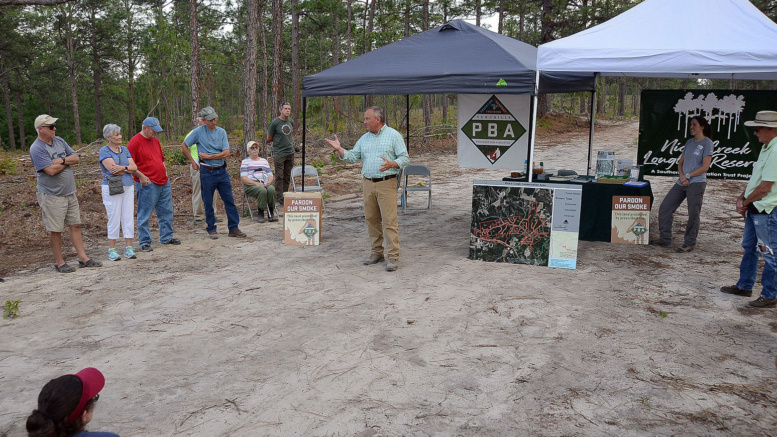‘A Real Game Changer’
Restoring native longleaf forests to large tracts in the Sandhills is a desirable though costly enterprise. An ambitious new project on the outskirts of Pinehurst aims to find the “magic sauce” that can synthesize economic and conservation forestry goals.
Nick’s Creek Longleaf Reserve is an 1,800-acre undeveloped stretch between N.C. 211 and N.C. 73 that was once destined to become a resort-like community of homes, hotel and spa, and two 18-hole golf courses. Known as Pine Forest when those plans were unveiled in 2009, developer MHK Ventures made slow progress following the economic downturn, and a series of challenges related to water and wastewater needs.
Quietly, in December 2019, the massive property was donated to Pine Forest Reserve LLC, according to the Moore County Register of Deeds. It is now managed by Southern Conservation Trust, a Georgia-based nonprofit that protects working farms, forests and historic landscapes through conservation easements and fee simple property donations.
The privately held Nick’s Creek Longleaf Reserve is operated, in part, as a demonstration ground for how receipt-based forestry can help bankroll longleaf restoration efforts.
“This is an experiment. It is a real game changer,” said Jesse Wimberley, coordinator with NC Sandhills Prescribed Burn Association. (SPBA). “It is not a recreation place, it is an education place. That is the niche they’re after.”
The large acreage includes the headwaters of Nick’s Creek, a waterway that runs from West End to Whispering Pines. It has been subdivided into smaller tracts where different types of forest management and restoration work will be utilized. One area may have undesired growth thinned and chipped, another area may be mulched, another will be burned — a necessary tool in longleaf management — and another will be treated with the addition of a chemical herbicide treatment.
Wimberley said the intentional projects serve two related national concerns; restoring forests while also looking at ways to mitigate wildfire risk.
“Whether by fire or mechanical means, historically the forest midstory was kept in check. But due to fire suppression efforts, we have this huge accumulation of fuel. That is a liability.” Wimberley said.
This midstory layer of vegetation is typically populated with low-value materials for the forestry and forestry commodities market. So, for example, in forests in the American West, removing that unwanted growth is pricey.
“What we are trying to do across the range is figure out how to turn a liability into an asset,” Wimberley said.
One potential relief valve is the wood pellet industry. North Carolina is home to several biomass or wood pellet exporters, including the Enviva plant in Hamlet.
Melvin Ezzell, a registered forester contracted by Southern Conservation Trust, said the wood pellet industry has received a bad reputation with environmentalists that he believes is unfair.
“Trees are a crop, a renewable, natural resource,” he said. “We are fortunate to have logging crews, mills and the wood pellet industry to help us monetize forestry.
“Forestry doesn’t happen overnight, it is a process. It is a marathon, not a sprint,” said Ezzell, noting the ultimate goal at Nick’s Creek is to restore 1,200 acres to longleaf savannah.
“Nick’s Creek can be used as an outdoor classroom for other landowners to see how they can see returns in forestry,” Wimberley added. “They can reduce their liability while increasing their assets, and we hope people will see that land that is retained can have a calming influence on growth. The goal is to figure out how to do it to benefit everybody.”
Contact Laura Douglass at (910) 693-2474 or laura@thepilot.com.











